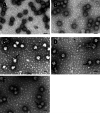Chemical composition and anti-Mayaro virus activity of Schinus terebinthifolius fruits
- PMID: 34631977
- PMCID: PMC8473526
- DOI: 10.1007/s13337-021-00698-z
Chemical composition and anti-Mayaro virus activity of Schinus terebinthifolius fruits
Abstract
Brazilian traditional medicine has explored the antiviral properties of many plant extracts, including those from the Brazilian pepper tree, Schinus terebinthifolius. In the present study, we investigated the chemical composition and anti-mayaro virus (MAYV) activity of S. terebinthifolius fruit. Extensive virucidal activity (more than 95%) was detected for the ethyl acetate extract and the isolated biflavonoids. From the ethyl acetate extract of Schinus terebinthifolius fruits, two bioflavonoids were isolated ((2S, 2″S)-2,3,2″,3″-tetrahydroamentoflavone and agathisflavone), which showed strong virucidal activity against Mayaro virus. Furthermore, several other compounds like terpenes and phenolics were identified by hyphenated techniques (GC-MS, LC-MS and HPLC-UV), as well as by mass spectrometry. Immunofluorescence assay confirmed antiviral activity and transmission electron microscopy revealed damage in viral particles treated with biflavonoids. The data suggest the direct action of the extract and the biflavonoids on the virus particles. The biflavonoids tetrahydroamentoflavone and agathisflavone had strong virucidal activity and reduced MAYV infection.
Supplementary information: The online version contains supplementary material available at 10.1007/s13337-021-00698-z.
Keywords: Antiviral; Biflavonoids; Schinus terebinthifolius; Virus mayaro.
© Indian Virological Society 2021.
Conflict of interest statement
Conflict of interestThe authors declare no conflict of interest.
Figures



Similar articles
-
Effects of structural differences on the antibacterial activity of biflavonoids from fruits of the Brazilian peppertree (Schinus terebinthifolius Raddi).Food Res Int. 2020 Jul;133:109134. doi: 10.1016/j.foodres.2020.109134. Epub 2020 Feb 27. Food Res Int. 2020. PMID: 32466911
-
Differentiation of Brazilian Peppertree (Schinus terebinthifolius Raddi) and Peruvian Peppertree (Schinus molle L.) Fruits by UHPLC-UV-MS Analysis of Their Anthocyanin and Biflavonoid Profiles.J Agric Food Chem. 2017 Jul 5;65(26):5330-5338. doi: 10.1021/acs.jafc.7b00480. Epub 2017 Jun 21. J Agric Food Chem. 2017. PMID: 28528547
-
Anti-Escherichia coli activity of extracts from Schinus terebinthifolius fruits and leaves.Nat Prod Res. 2018 Jun;32(11):1365-1368. doi: 10.1080/14786419.2017.1344657. Epub 2017 Jul 3. Nat Prod Res. 2018. PMID: 28669243
-
An update on the development of antiviral against Mayaro virus: from molecules to potential viral targets.Arch Microbiol. 2023 Mar 7;205(4):106. doi: 10.1007/s00203-023-03441-y. Arch Microbiol. 2023. PMID: 36881172 Free PMC article. Review.
-
Natural biflavonoids as potential therapeutic agents against microbial diseases.Sci Total Environ. 2021 May 15;769:145168. doi: 10.1016/j.scitotenv.2021.145168. Epub 2021 Jan 16. Sci Total Environ. 2021. PMID: 33493916 Review.
Cited by
-
Mayaro Virus: The State-of-the-Art for Antiviral Drug Development.Viruses. 2022 Aug 16;14(8):1787. doi: 10.3390/v14081787. Viruses. 2022. PMID: 36016409 Free PMC article. Review.
-
Robust Antiviral Activity of Santonica Flower Extract (Artemisia cina) against Avian and Human Influenza A Viruses: In Vitro and Chemoinformatic Studies.ACS Omega. 2022 Nov 2;7(45):41212-41223. doi: 10.1021/acsomega.2c04867. eCollection 2022 Nov 15. ACS Omega. 2022. PMID: 36406485 Free PMC article.
References
LinkOut - more resources
Full Text Sources
Miscellaneous

